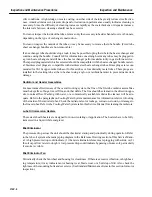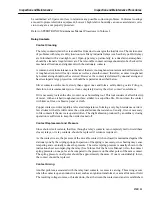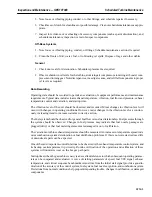
Inspection and Maintenance
Inspection and Maintenance Procedures
IMP–21
be maintained at 50 percent or less to minimize any possible corrosion problems. Conformal coatings
are used to protect electronic equipment; however, high relative humidity can cause accelerated corro-
sion in any area not properly protected.
Refer to SPEEDTRONIC Maintenance Manual Procedures in Volume I.
Relay Contacts
Contact Cleaning
The relay contact(s) must be clean and free from dust to energize the load device. The main source
of problems with relays is dirty load contacts. Many industrial relays (such as the type HGA relay)
are furnished with a dust-tight cover. Open-type relays, particularly in a dust-laden atmosphere,
should be cleaned at regular intervals. The removable contact carriage should also be checked for
mechanical freedom and alignment with the stationary contacts.
A common error in maintenance is the belief that service-roughened contacts must be filed smooth.
A roughened contact will carry current as well as a smooth contact; therefore, a contact roughened
by normal arcing should not be serviced. However, if a contact is deformed by unusual arcing and
has developed a large projection, it should be repaired as described below.
Silver contacts oxidize more slowly than copper ones and form a self-reducing oxide. Filing is,
therefore, not recommended, since it can completely destroy the silver contact’s usefulness.
If it is necessary to clean the silver contact, use a burnishing tool. This tool consists of a flexible strip
of metal, with an etched (roughened) surface, similar to a superfine file. Do not clean the contact
with knives, files, or abrasive paper or cloth.
Copper contacts oxidize rapidly at elevated temperatures, forming a very high resistance oxide. A
few strokes with a file will remove the oxide and reduce the resistance. Usually, it is not necessary
to file contacts if the device is operated often. The slight abrasion produced by an ordinary closing
operation is sufficient to keep the oxide cleaned off.
Contact Replacement and Pressure
Since short-circuit currents, that flow through a relay’s contacts, can completely melt or weld them
closed, relays, or relay contacts, should be replaced if evidence requires it.
As the contact wears, the pressure of the movable contact (when closed) is maintained against the
stationary one by the wiping springs. Inspection of the spring is necessary, since heating may cause
tempering and eventually reduce the pressure. The correct spring pressure is usually shown in the
instruction sheet accompanying the relay. (See Volume II of the Service Manual.) Also, the contact
spring pressure on one pole can be compared to the pressure on the other poles of the same contact.
The spring pressure on all poles should be approximately the same. If one is considerably lower,
the contact should be replaced.
Contact Arcing
Another problem, associated with the relay load contacts, is excessive arcing. This arcing occurs
when the contacts open an inductive load, such as an ignition transformer, or a small dc motor field.
The resulting voltage ionizes, or breaks down, the air between the contacts and an arc is established.
Summary of Contents for MS6001B
Page 2: ...Gas Turbine Inspection and Maintenance GEK 107048 I 2 THIS PAGE INTENTIONALLY LEFT BLANK ...
Page 4: ...Inspection and Maintenance Note THIS PAGE INTENTIONALLY LEFT BLANK ...
Page 13: ...INSERT TAB INTRODUCTION ...
Page 14: ......
Page 25: ...INSERT TAB STANDARD PRACTICES ...
Page 26: ......
Page 87: ...INSERT TAB AUXILIARY CONTROLS SYSTEMS MAINTENANCE ...
Page 88: ......
Page 133: ...INSERT TAB SCHEDULED TURBINE MAINTENACE ...
Page 134: ......
Page 157: ...INSERT TAB COMBUSTION INSPECTION ...
Page 158: ......
Page 239: ...INSERT TAB HOT GAS PATH INSPECTION ...
Page 240: ......
Page 313: ...INSERT TAB MAJOR INSPECTION ...
Page 314: ......
Page 316: ...Inspection and Maintenance GEK 107048 Major Inspection 2 THIS PAGE INTENTIONALLY LEFT BLANK ...
Page 363: ...INSERT TAB MAINTENANCE FORMS ...
Page 364: ......
















































